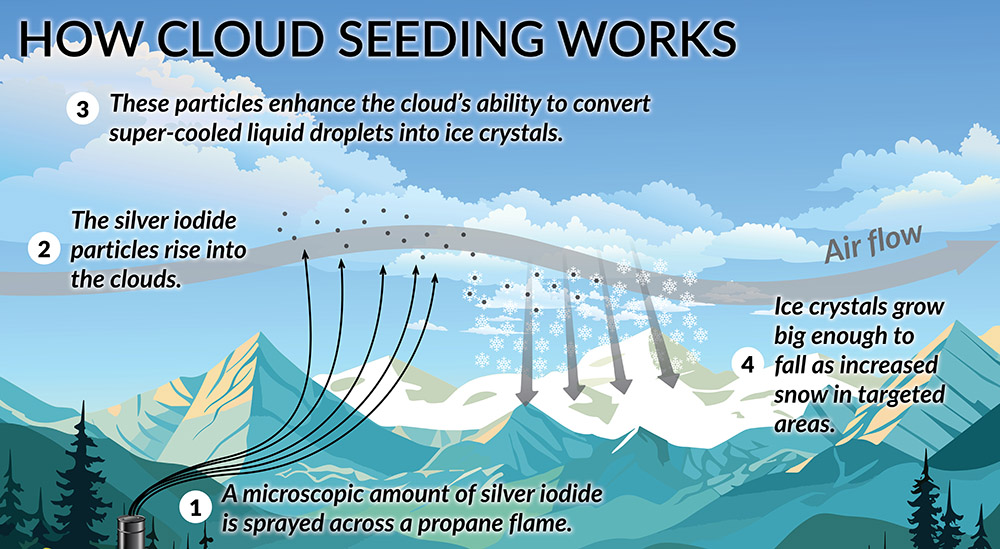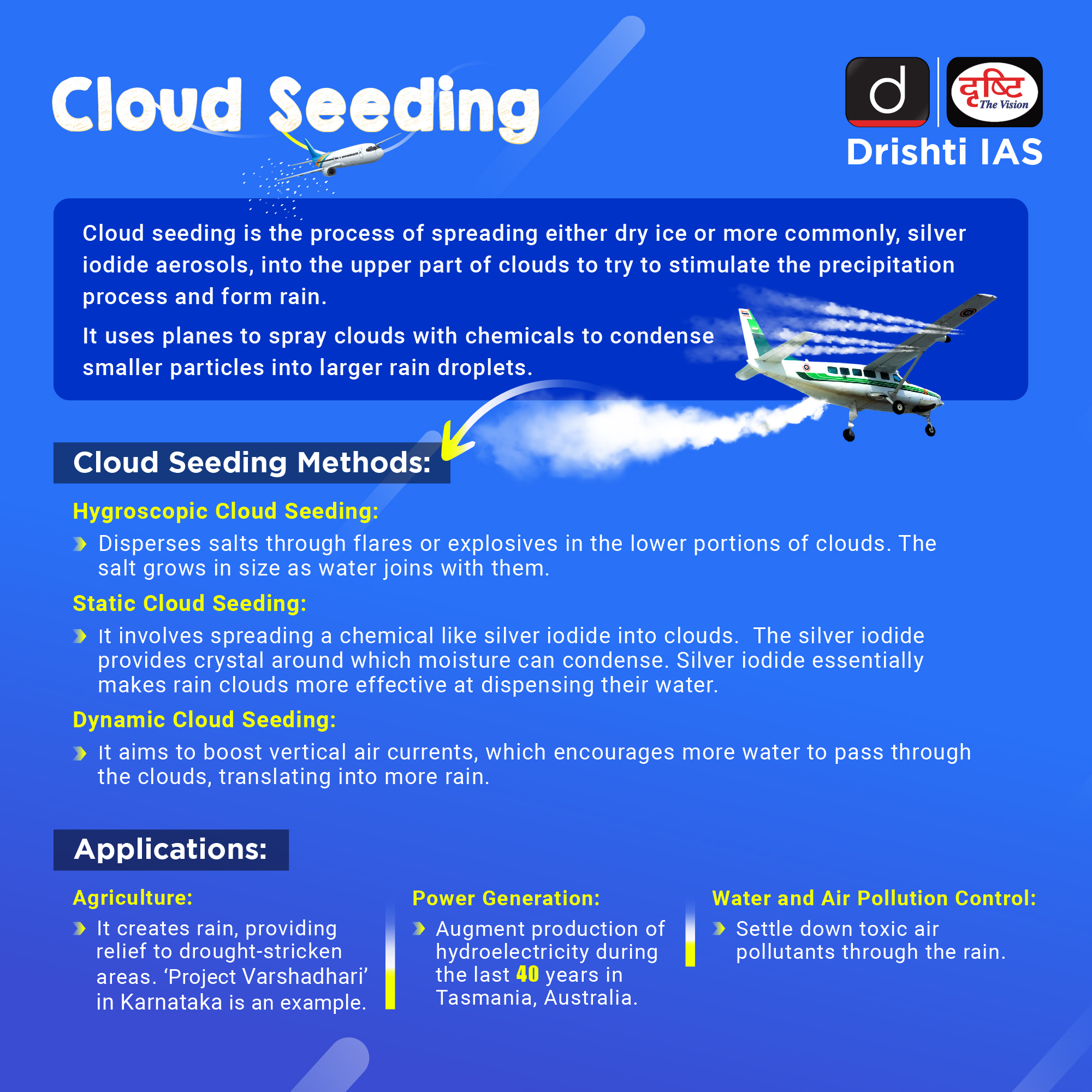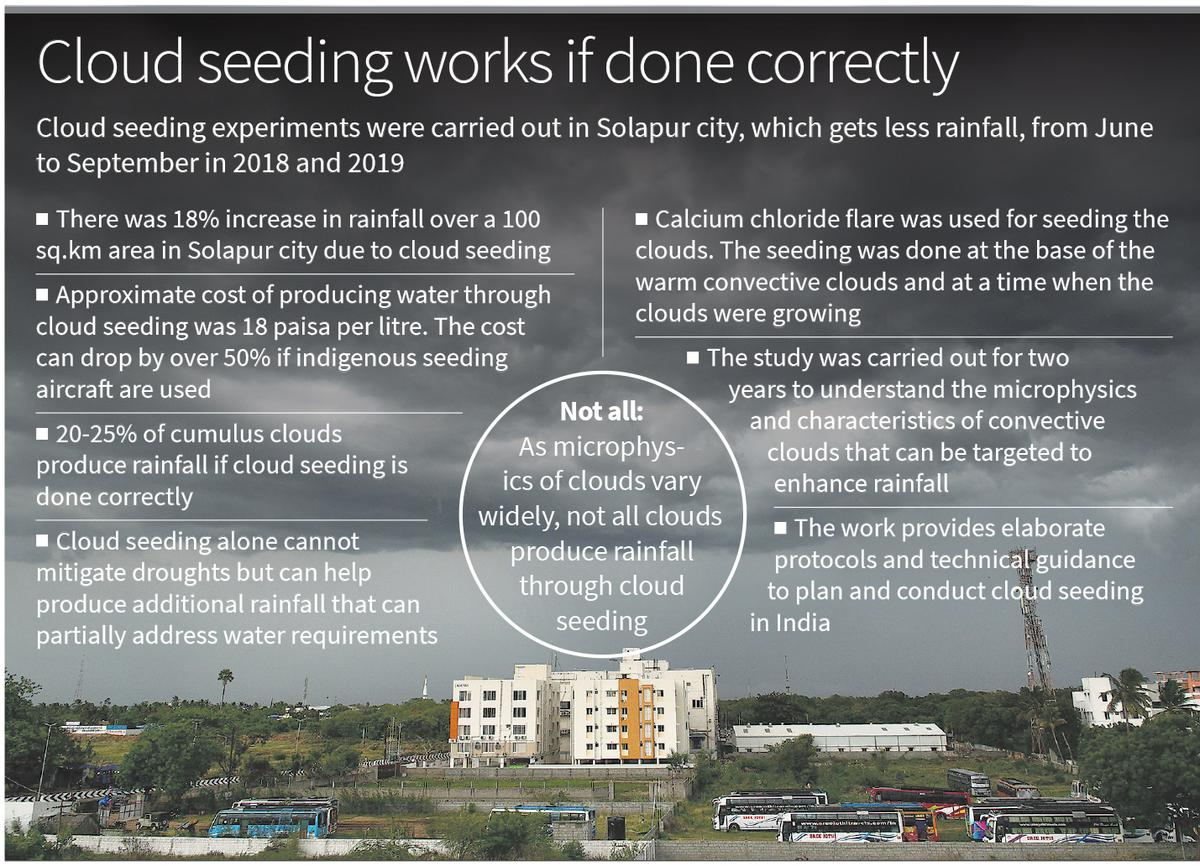Science & Technology
Cloud Seeding in Delhi
- 27 Oct 2025
- 10 min read
For Prelims: Cloud seeding, Particulate matter, Indo-Gangetic Plain, India Meteorological Department
For Mains: Science and technology in environmental management, Urban air pollution and sustainable development in India
Why in News?
The Delhi government partnered with IIT-Kanpur to conduct cloud seeding experiments to combat rising post-monsoon air pollution.
- However, experts from the Ministry of Earth Sciences have cautioned that the absence of rain-bearing clouds during the post-monsoon season makes the timing scientifically unsuitable, casting doubt on the effectiveness of the initiative.
What is Cloud Seeding?
- About: Cloud seeding is a weather modification technique aimed at enhancing precipitation (rain or snow) from existing clouds.
- Mechanism: It involves dispersing substances such as silver iodide, potassium iodide, sodium chloride, or dry ice (solid CO₂) into clouds using aircraft.
- These particles act as cloud condensation nuclei (CCN) or ice nuclei (IN), mimicking the structure of ice and prompting supercooled water droplets in the clouds to freeze.
- As these ice crystals grow larger and heavier, they eventually coalesce and fall to the ground as rain or snow.
- Cloud seeding cannot create clouds, but works only when there are naturally formed clouds with sufficient moisture.
- Cloud Seeding in India & Across Globe: The India’s Ministry of Earth Sciences (MoES) has conducted several studies under the Cloud Aerosol Interaction and Precipitation Enhancement Experiment (CAIPEEX).
- These experiments, conducted in phases between 2009 and 2019, showed that rainfall could be increased by up to 46% under favourable conditions.
- States like Maharashtra, Karnataka, Andhra Pradesh, and Tamil Nadu have experimented with cloud seeding for drought relief.
- China extensively uses cloud seeding for weather control, especially before major events (e.g., 2008 Beijing Olympics).
- UAE and Saudi Arabia regularly use cloud seeding to tackle water scarcity.
- Applications of Cloud Seeding: Enhancing rainfall in drought-prone or arid regions.
- Reducing air pollution by washing out pollutants (as proposed in Delhi).
- Dispersing fog near airports or highways to improve visibility.
- Suppressing hailstorms or modifying weather for agricultural purposes.
What are the Limitations of Using Cloud Seeding to Curb Air Pollution?
- Lack of Rain-bearing Clouds: The India Meteorological Department (IMD) classifies October to December as the post-monsoon season, when monsoon clouds and low-pressure systems have already withdrawn.
- The atmosphere is mostly dry and stable, with limited vertical motion needed for cloud formation.
- Even when clouds are present, their composition, temperature, and moisture levels must be ideal for seeding. As cloud seeding only works on existing, moisture-laden ones.
- Dependence on Western Disturbances: During this period, any rainfall in North India typically comes from western disturbances (weather systems originating in the Mediterranean).
- These are infrequent and unpredictable, making it difficult to plan cloud seeding operations in advance.
- Limited and Temporary Impact: Any rain produced through seeding would offer only short-term relief from pollution by temporarily washing out particulate matter. The pollution levels would rise again once emissions continue.
- Environmental Risks: Chemicals like silver iodide used for seeding can accumulate in soil and water, though their long-term effects are still debated.
- Accountability Risks: If cloud seeding coincides with flooding or extreme rainfall, the public may blame the intervention, whether or not it’s responsible.
- There are no clear frameworks for accountability, making it hard to assign responsibility if harm occurs.
- Misallocation of resources: The absence of region-specific scientific data limits the effectiveness of cloud seeding, making it difficult to assess its results or justify the investment, while diverting funds from proven, evidence-based solutions.
What are the Persistent Causes of Air Pollution in Delhi?
- Vehicular Emissions: Delhi has over 1.2 crore registered vehicles, one of the highest in the country.
- Exhaust from petrol and diesel engines releases particulate matter (PM), nitrogen oxides, and carbon monoxide, which are major contributors to urban smog.
- Crop Residue Burning: Smoke from stubble burning in neighbouring Punjab and Haryana drifts into Delhi every winter, significantly increasing PM2.5 levels across the NCR region.
- Industrial and Construction Pollution: Continuous construction and demolition activities release large amounts of dust and suspended particles. Poor dust control measures worsen local air quality.
- Small- and medium-scale industries in and around Delhi, including in areas like Bawana and Wazirpur, often use dirty fuels such as coal, biomass, or furnace oil, adding to toxic emissions.
- Meteorological and Geographical Factors: During winter, weak winds, low temperatures, and temperature inversion trap pollutants near the surface.
- The city’s location in the Indo-Gangetic Plain further restricts air circulation, allowing pollutants to accumulate leading to increased pollution.
What are the Sustainable Solutions to Delhi’s Air Pollution Crisis?
- Emission Control: Enforce stricter vehicle norms and promote EVs under the Electric Mobility Promotion Scheme (EMPS) 2024 with better charging infrastructure and awareness drives.
- Industrial and Power Regulation: Strengthen monitoring under the National Clean Air Programme (NCAP), enforce strict Graded Response Action Plan, and phase out coal-based power plants near NCR.
- Waste Management: Ban open waste burning, improve segregation and recycling, and follow models like Surat's clean construction handbook and waste management strategy (led to reduction of open waste burning from 25% to 2% between 2015 and 2020) and Indore’s waste system for better results.
- Crop Residue Management: Promote Happy Seeder and subsidised Crop Residue Management (CRM) machines to discourage stubble burning and offer incentives for sustainable farming practices.
- Green Infrastructure: Expand urban forests, parks, and green belts to absorb pollutants and reduce heat and dust.
- Public Participation: Encourage citizens to carpool, cut waste, conserve energy, and follow air-quality advisories.
Conclusion
- Cloud seeding is a promising yet scientifically uncertain tool for weather modification. While it can supplement water management efforts or temporarily reduce pollution, it is not a substitute for structural environmental reforms.
For India, the priority should remain on sustainable water management, emission reduction, and clean energy adoption, rather than relying on short-term weather engineering solutions.
|
Drishti Mains Question: Q. Cloud seeding offers a temporary fix but not a solution to India’s air pollution crisis. Discuss |
Frequently Asked Questions (FAQs)
1. What is Cloud Seeding?
It is a weather modification technique that disperses substances like silver iodide, potassium iodide, sodium chloride, or dry ice into clouds to enhance precipitation.
2. What is the purpose of the Electric Mobility Promotion Scheme (EMPS) 2024?
To accelerate the adoption of electric vehicles (EVs) and reduce vehicular emissions contributing to urban air pollution.
3. What is the Happy Seeder machine used for?
It enables in-situ management of crop residue by sowing seeds directly into the soil without burning stubble.
4. What is the Graded Response Action Plan (GRAP)?
It is a set of emergency measures implemented in the Delhi-NCR region to control air pollution based on the severity of air quality levels.
UPSC Civil Services Examination, Previous Year Questions (PYQs)
Prelims
Q. Artificial way of causing rainfall to reduce air pollution makes use of
A. silver iodide and potassium iodide
B. silver nitrate and potassium iodide
C. silver iodide and potassium nitrate
D. silver nitrate and potassium chloride
Ans: A
Q. In the context of which of the following do some scientists suggest the use of cirrus cloud thinning technique and the injection of sulphate aerosol into the stratosphere? (2019)
(a) Creating the artificial rains in some regions
(b) Reducing the frequency and intensity of tropical cyclones
(c) Reducing the adverse effects of solar wind on the Earth
(d) Reducing the global warming
Ans: (d)









